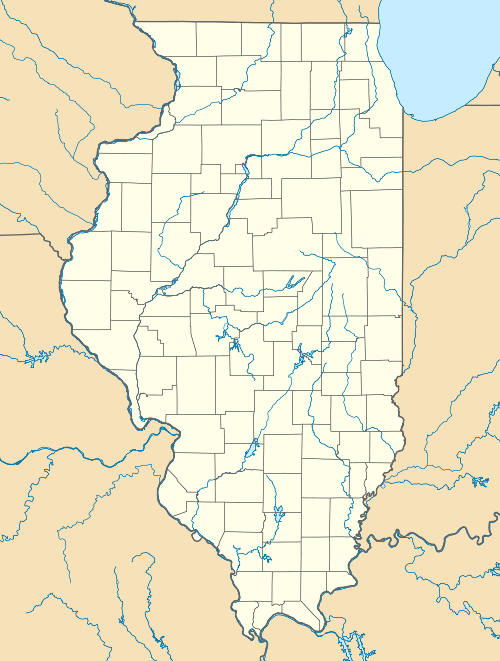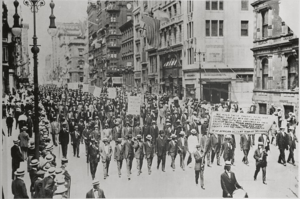East St. Louis riots

The East St. Louis riots (also known as the East St. Louis massacres) of May and July 1917 were an outbreak of labor- and race-related violence that caused between 40 and 200 deaths and extensive property damage. The events took place in East St. Louis, Illinois, an industrial city on the east bank of the Mississippi River across from St. Louis, Missouri. They have been described as the worst case of labor-related violence in 20th-century American history,[1] and among the worst race riots in U.S. history. The local Chamber of Commerce called for the resignation of the police chief. At the end of July, some 10,000 people marched in silent protest in New York City in condemnation of the riots.
Background

In 1917 the United States had an active economy boosted by World War I. With many would-be workers absent for active service in the war, industries were in need of labor. Seeking better work and living opportunities, as well as an escape from harsh conditions, the Great Migration of African Americans out of the South toward industrial centers across the northern and midwestern United States was well underway. For example, blacks were arriving in St. Louis during Spring 1917 at the rate of 2,000 per week.[2] When industries became embroiled in labor strikes, traditionally white unions sought to strengthen their bargaining position by hindering or excluding black workers, while industry owners utilizing blacks as replacements or strikebreakers added to the deep existing societal divisions.[3]
While in New Orleans on a lecture tour, black leader Marcus Garvey became aware that Louisiana farmers and the Board of Trade were worried about losing their labor force, and had requested East St. Louis Mayor Mollman's assistance during his New Orleans visit that same week to help discourage black migration.[2]
With many blacks finding work at the Aluminum Ore Company and the American Steel Company in East St. Louis, some whites feared job and wage security due to this new competition; they further resented newcomers arriving from a rural and very different culture. Tensions between the groups escalated, including rumors of black men and white women fraternizing at a labor meeting on May 28.[4][5]
Riots
Following the May 28 meeting, some 3,000 white men marched into downtown East St. Louis and began attacking African Americans. With mobs destroying buildings and beating people, the governor of Illinois called in the National Guard to prevent further rioting. Although rumors circulated about organized retribution attacks from blacks,[4] conditions eased somewhat for a few weeks.
On July 2, a car occupied by white males drove through a black area of the city and fired several shots into a standing group. An hour later, a car containing four people, including a journalist and two police officers (Detective Sergeant Samuel Coppedge and Detective Frank Wadley) were passing through the same area. Black residents, possibly assuming they were the original suspects, opened fire on their car, killing one officer instantly and mortally wounding another.[4][6] Later that day, thousands of white spectators who assembled to view the detectives' bloodstained automobile marched into the black section of town and started rioting.[7] After cutting the water hoses of the fire department, the rioters burned entire sections of the city and shot inhabitants as they escaped the flames.[4] Claiming that "Southern negros deserve[d] a genuine lynching,"[8] they lynched several blacks. Guardsmen were called in but accounts exist that they joined in the rioting rather than stopping it.[9][10] More joined in, including allegedly "ten or fifteen young girls about 18 years old, [who] chased a negro woman at the Relay Depot at about 5 o'clock. The girls were brandishing clubs and calling upon the men to kill the woman."[4][11] After the riots, the St. Louis Argus said, "The entire country has been aroused to a sense of shame and pity by the magnitude of the national disgrace enacted by the blood-thirsty rioters in East St. Louis Monday, July 2."[12]
Aftermath
Death toll
After the riots, varying estimates of the death toll circulated. The police chief estimated that 100 blacks had been killed.[2] The renowned journalist Ida B. Wells reported in The Chicago Defender that 40-150 black people were killed during July in the rioting in East St. Louis.[10][13] The N.A.A.C.P. estimated deaths at 100–200. Six thousand blacks were left homeless after their neighborhood was burned. A Congressional Investigating Committee concluded that no precise death toll could be determined, but reported that at least 8 whites and 39 blacks died.[14] While the coroner specified nine white deaths, the deaths of black victims were less clearly recorded. Activists who disputed the Committee's conclusion, argued that the true number of deaths would never be known because many corpses were not recovered, or did not pass through the hands of undertakers.[15]
The black community's reaction

The ferocious brutality of the attacks and the failure of the authorities to protect innocent lives contributed to the radicalization of many blacks in St. Louis and the nation.[16] Marcus Garvey declared in an inflammatory speech that the riot was "one of the bloodiest outrages against mankind" and a "wholesale massacre of our people", insisting that "This is no time for fine words, but a time to lift one's voice against the savagery of a people who claim to be the dispensers of democracy."[2][17]
In New York City on July 28, ten thousand black people marched down Fifth Avenue in a Silent Parade, protesting the East St. Louis riots. They carried signs that highlighted protests about the riots. The march was organized by the National Association for the Advancement of Colored People (NAACP), W. E. B. Du Bois, and groups in Harlem. Women and children were dressed in white; the men were dressed in black.[16]
The business community's reaction
On July 6 representatives of the Chamber of Commerce met with the mayor to demand the resignation of the Police Chief and Night Police Chief, or radical reform. They were outraged about the rioting and accused the mayor of having allowed a "reign of lawlessness." In addition to the riots taking the lives of too many innocent people, mobs had caused extensive property damage. The Southern Railway Company's warehouse was burned, with over 100 car loads of merchandise, at a loss to the company of over $525,000; a white theatre valued at more than $100,000, was also destroyed.[2] 44 freight cars and 312 houses were destroyed.[18]
References
- ↑ Fitch, Solidarity for Sale, 2006, p. 120.
- 1 2 3 4 5 "Speech by Marcus Garvey, July 8, 1917". Excerpts from Robert A. Hill, ed. The Marcus Garvey and Universal Negro Improvement Association Papers, Volume I, 1826 – August 1919. Berkeley and Los Angeles: University of California Press, 1983, accessed 1 February 2009, PBS, American Experience.
- ↑ Winston James, Holding Aloft the Banner of Ethiopia, New York: Verso, 1998, p. 95.
- 1 2 3 4 5 Rudwick, Race Riot at East St. Louis, 1964.
- ↑ Leonard, "E. St. Louis Riot", St. Louis Post-Dispatch, January 13, 2004.
- ↑ "Detective Sergeant Samuel Coppedge", Officer Down Memorial Page.
- ↑ Buescher, John. "East St. Louis Massacre." Teachinghistory.org. Accessed 11 July 2011.
- ↑ Heaps, "Target of Prejudice: The Negro", in Riots, USA 1765-1970, p. 114.
- ↑ Gibson, The Negro Holocaust: Lynching and Race Riots in the United States, 1880-1950, 1979.
- 1 2 Patrick, "The Horror of the East St. Louis Massacre", Exodus, February 22, 2000.
- ↑ "Race Rioters Fire East St. Louis and Shoot or Hang Many Negroes", The New York Times, July 3, 1917.
- ↑ "Negroes Did Not Start Trouble". The St. Louis Argus. July 6, 1917. Retrieved August 23, 2016.
- ↑ Wells, Crusade for Justice: The Autobiography of Ida B. Wells, rev. ed., 1991.
- ↑ Congressional Edition, Volume 7444, House of Representatives 65th Congress 2nd Session document # 1231, 1918.
- ↑ Elliott M. Rudwick, Race Riot at East St. Louis, July 2, 1917, Carbondale: Southern Illinois University Press, 1964, p. 50.
- 1 2 James (1998), Holding Aloft the Banner of Ethiopia, p. 96.
- ↑ Herbert Shapiro, White Violence and Black Response: From Reconstruction to Montgomery, University of Massachusetts Press, 1988, p. 163.
- ↑ Congressional Edition, Volume 7444, House of Representatives 65th Congress 2nd Session document # 1231, 1918, pp. 1, 6.
Sources
- Barnes, Harper. Never Been a Time: The 1917 Race Riot That Sparked the Civil Rights Movement, New York: Walker & Company, June 24, 2008. ISBN 0-8027-1575-3.
- Fitch, Robert. Solidarity for Sale. Cambridge, Mass.: Perseus Books Group, 2006. ISBN 1-891620-72-X.
- Gibson, Robert A. The Negro Holocaust: Lynching and Race Riots in the United States, 1880-1950. New Haven: Yale University, 1979.
- Heaps, Willard A. "Target of Prejudice: The Negro", In Riots, USA 1765-1970. New York: The Seabury Press, 1970.
- Leonard, Mary Delach. "E. St. Louis Riot." St. Louis Post-Dispatch. January 13, 2004.
- Lumpkins, Charles L. "American Pogrom: The East St. Louis Race Riot and Black Politics." Athens, Ohio: Ohio University Press, 2008. ISBN 978-0-8214-1802-4, ISBN 0-8214-1802-5.
- McLaughlin, Malcolm. "Power, Community, and Racial Killing in East St. Louis." New York: Palgrave Macmillan, 2005. ISBN 1-4039-7078-5.
- McLaughlin, Malcolm. "Reconsidering the East St Louis Race Riot of 1917", International Review of Social History. 47:2 (August 2002).
- "Race Rioters Fire East St. Louis and Shoot or Hang Many Negroes". The New York Times. July 3, 1917.
- Patrick, James. "The Horror of the East St. Louis Massacre." Exodus. February 22, 2000.
- Rudwick, Elliott M. Race Riot at East St. Louis. Carbondale, Ill.: Southern Illinois University Press, 1964.
- Wells, Ida B. Crusade for Justice: The Autobiography of Ida B. Wells. Rev. edn. Chicago: University of Chicago Press, 1991. ISBN 0-226-89344-8.
External links
- The Crisis Magazine, August 1917 report on East St Louis Riot, pp. 177–178.
- The Crisis Magazine, September 1917, pp. 219–237, report on the East St Louis riot
- The Crisis Magazine, April 1922, pp. 17–22.
- "Primary Sources: The Conspiracy Of The East St. Louis Riots", The American Experience. PBS.com.
- "Useful readings on the Riots compiled by Southern Illinois University Edwardsville's Institute For Urban Research
- Tim O'Neil, "Look Back: Worker struggles, racial hatred in East St. Louis explodes in white rioting", St. Louis Post-Dispatch, July 1, 2012, and "Worker struggles, racial hatred in East St. Louis explodes in white rioting", St. Louis Post-Dispatch, September 21, 2014.